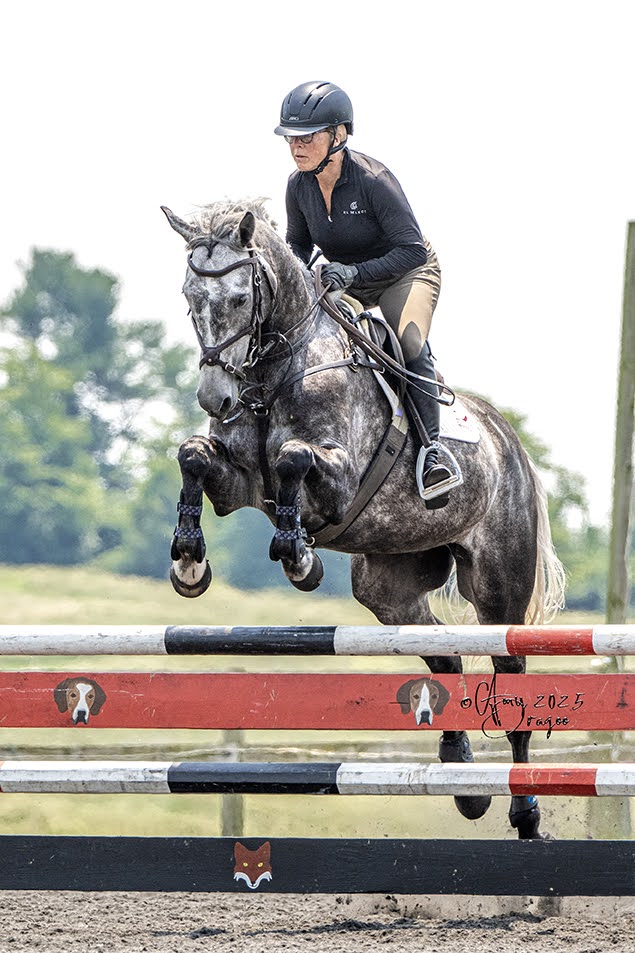The 2018 International Eventing Forum took place at Hartpury College, a leading education and competition centre in Gloucestershire, England, on the 5th of February. For a full report of the first session of the day, led by dressage guru Sandy Phillips, click here. For an insight into training the event horse over fences with international coach Eric Smiley, click here.

Charlie Unwin unpacks positive psychology at the International Eventing Forum. Photo by Tilly Berendt.
I will never stop believing that the consumption of carbs helps the absorption of information into the brain, and my convictions served me well at the IEF, because the post-lunch session yielded a wealth of brain food to mull over.
“The mind limits the body” – performance psychology with Charlie Unwin
The first speaker after the break was performance psychologist Charlie Unwin, who works with world class athletes from a wide variety of sports, but whose involvement in the equestrian industry has gained him a large and devoted following.
In his fascinating talk, he posited that belief – or the lack thereof – can directly affect the way our bodies respond to the circumstances in which they find themselves.
“In our minds, we always come back to things that have gone wrong,” he explained. “Being healthy means we’re not ill, happiness is the absence of sadness. But why should we define good performance as the absence of bad performance?”
Positive psychology, Charlie said, can be used not only to produce the best possible performance in competition, but also to take the most benefit from a training session or lesson. He explained that he encourages his clients to create what he calls ‘mental blueprints’ – a system of goals and targets, utilising positive visualisation, rather than trying to avoid mistakes or faults. This helps to readdress the way they look at their performance, and also breaks big goals down into achievable, buildable targets.
The power of that positive thinking is potent.
“You’re more likely to become what you believe you’ll become – belief is very, very powerful. Your thoughts have a way of going to your hands, your feet, and your seat,” said Charlie. He used the example of runner Roger Bannister and his quest to beat the four-minute mile. In 1945, the world record for running a mile had been set by Sweden’s Gunder Hagg, who set a time of four minutes and 1.3 seconds. This, it was claimed, was the absolute fastest time in which a mile could be run – to go any faster would be outside the realm of human capability and to even try, it was said, would result in catastrophic consequences, such as a heart attack or organ failure. For nearly ten years, no one came close to beating Hagg’s record.
Then, in 1954, 25-year-old Roger Bannister turned the notion on its head. After a long period of training and intensely visualising the achievement, he set a new record of three minutes, 59.4 seconds. He would not hold this record for long: once other runners believed the four-minute mile could be beaten, they began to do so with remarkable regularity. Now, a sub-four minute mile is still an impressive athletic feat, but it isn’t at all uncommon.
This is the same sort of phenomenon that powers incredibly consistent riders, such as Michael Jung, explained Charlie. It’s not that he’s superhuman or possesses an unachievable level of talent – it’s that he pairs hard work and consistent training with an unshakeable belief that he can ride a competitive dressage test, jump an easy double-clear, or leave all the poles up on the final day. He doesn’t place unnecessary limits on himself or his horses by worrying about what might go wrong – instead, he pictures an end goal and works towards it, believing every step of the way that he’ll make it there.
One of the things that makes eventing so unique is that amateur riders find themselves up against the best in the business – not just professionals, but household names. This can diminish your performance or it can enhance it – it all depends on how you view yourself, says Charlie.
“You’ll learn more about the human condition by watching the warm-up arena than anything else. It’s the only spot where you can be warming up next to a world champion, and how you see yourself can dictate how you perform.” He advised using these professionals as tangible examples of goals – instead of thinking that you’ll never beat them because of who they are, or worrying that you’ll embarrass yourself, look at the professional in the arena and realise that their level of competence is the reason why you’re doing what you’re doing – every moment of committed riding is one step closer to their level of skill.
Charlie also spoke about ‘coding’ – associating various experiences with appropriate mindsets. Riders should enter the dressage arena not thinking about merely getting to the next phase, but rather, by adopting the mindset of a world class dressage rider, heading down the centreline on the world stage. This instills a level of self-belief and confidence, which can upgrade your ride from good to great.

Charlie Unwin at the IEF. Photo by Tilly Berendt.
Failure was another of the points of Charlie’s speech: in particular, riders’ fixation on it. Generally, he explained, you’ll replay a failure or mistake in your head about five times more than you’ll replay something you did well. This can inflate the influence of the mistake and make it seem all-encompassing. Instead, he said, failure should be considered a learning opportunity, and relative to what you set out to do. In your goal-setting blueprints, you should also be setting short-term goals in the competition ring – for example, you might aim to land on the correct lead after every fence, or sit tall on the approach and not chase your horse into a stride. Whatever goal you set for the ride, you can use it as a barometer of success. Did you knock two rails? Perhaps, but did you accomplish your goal of landing on the correct lead every time? Great, then that’s a victory to celebrate.
Fear, too, was on the agenda. Physiologically, he explained, fear is almost exactly the same as excitement – the only difference is control. If you feel fearful in a situation, ask yourself: how can I regain control and move this situation back into my comfort zone?
One of the points that Charlie made that was particularly pertinent to the amateur rider was the idea of quality over quantity. He posited that more hours in the saddle isn’t actually the quickest route to becoming a more competent rider – instead, making best use of the time you have is more conducive to improvement. Again, goal-setting helps enormously here – having specific, achievable goals every time you saddle up stops you from logging aimless hours in the saddle, and allows you to improve even if your riding time is limited.
Finally, Charlie spoke to the audience about the ability to focus on the task at hand, and the importance of this for competitive success. The rare moments of total focus that he calls ‘flow states’ might seem hard to achieve, but this is because the intensity of competition rarely factors into our training routine. As a former world class pentathlete, he spoke about introducing this intensity into his own training, by visualising high-pressure situations until his heart rate increased considerably. Then, he trained and worked through the pressure. In competition, he found he was able to focus considerably better and perform to the standard he would in training.
“Preparing for the top” – advanced jumping skills with Swedish team coach Fredrik Bergendorff

Imogen Murray and Ivar Gooden work in at the IEF. Photo by Tilly Berendt.
In the final session of the day, Fredrik worked with two top-class riders – Ludwig Svennerstal, who rode Novice horses Flora and NBE Dexter, and Imogen Murray, who rode four-star campaigner and EquiRatings 2017 Horse of the Year nominee Ivar Gooden. From a session jam-packed with useful tidbits, we took away the following:
- The warm-up is the most crucial part of your ride. If you only have 25 minutes to ride, spend that time doing the best warm-up you can, and then put your horse away. Don’t ever be tempted to skip it to get to the ‘good stuff’
- You should establish rhythm, suppleness and connection before you move on to anything else
- Keep your reins longer in the warm-up: if your horse’s nose is pointing to his chest, his shoulder can’t move. Only when the shoulder is free can the hind-end engage

Ludwig Svennerstal and Flora demonstrate the increased mobility afforded by trot poles. Photo by Tilly Berendt.
- Trot-poles can be used to encourage your horse to use his full range of motion. Leg-yield is also a useful tool for getting him to use his body
- Most riders are guilty of riding an underpowered canter at home. Think medium canter when creating a jumping pace
- If you can find your balance point in the middle of your horse’s canter, everything becomes much easier and you don’t have to overcompensate to get yourself over a fence

Imogen Murray and Ivar Gooden clear a sizeable fence off of a tight turn. Photo by Tilly Berendt.
- Make adjustments to pace, stride, or impulsion before you turn into a fence, rather than on the approach – by the time you and your horse have locked on, you want to focus on maintaining the rhythm
- Confidence comes from having a process that you can capably repeat time and time again – not from winging it and hoping for the best
- Press your horse forward from your leg to your hand in the first stride after landing from a fence
- Straightness is so important – in fact, it’s the key to a clean effort over a fence
- Counter canter is a great exercise to establish straightness, particularly with a horse that’s prone to overbending
- Holding your reins up in front of you, rather than down and back, keeps your upper body tall and in the correct position for jumping

Ludwig Svennerstal and NBE Dexter over Fredrik Bergendorff’s course. Photo by Tilly Berendt.
- Showjumping courses are simply a series of turns – from long, flowing ones to rollbacks. Ride between each fence as though it’s a related distance
- Make the basics as good as you can and always assess what’s going on beneath you so you can ask, ‘what can I do to make this better?’
So there you have it – by unlocking the subtleties of your seat, building a sensible and progressive foundation, believing in your own capabilities, and embracing the art of riding forward into a fence, the answer to the overarching question of ‘what’s the limit?’ becomes very easy to answer.

I wrote many thousands of words just to be able to use this GIF.
And that’s it from this year’s jam-packed International Eventing Forum! The IEF will return to Hartpury College on the 4th of February 2019. Tickets are available here.
















































